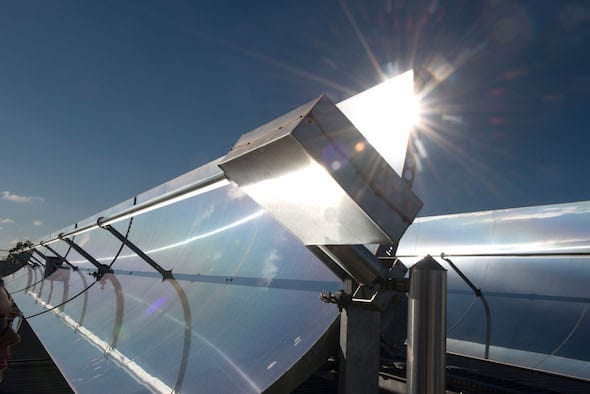A solar thermal powered air-conditioning system that concentrates the heat of the sun to cool large commercial spaces has been installed at a shopping centre in regional Victoria.

The CSIRO-developed system was unveiled on Friday, and is now in operation on the roof of the Stockland Wendouree Shopping Centre in Ballarat, where it will provide humidity controlled fresh air for the centre and significantly reduce its electricity usage.
The technology – the result of a $1.2 million project jointly managed by CSIRO with Stockland Group and NEP Solar, and with $520,000 in funding from the Australian Renewable Energy Agency – uses concentrating solar thermal collectors to produce heat energy used to power the air conditioning system.
Powered by NEP Solar’s trough collectors (pictured below) the system stores heat stored in a thermal oil tank. A closed-loop system uses two ‘desiccant’ wheels to remove moisture from the air, acting as a dehumidifier.
A high-temperature wheel uses solar heat for regeneration while a low temperature wheel functions without any external heat to deliver greater efficiency on a commercial scale.

As a bonus, the CSIRO’s solar air-con system also requires around 40 per cent less roof space than a traditional single-stage desiccant system.
The main aim of the system is to address the high energy consumption of large commercial spaces like shopping centres and hotels, whose heating and cooling requirements make up around 60 per cent of total electricity use.
So far, CSIRO Energy Director Peter Mayfield says he is extremely pleased with the results.
“CSIRO’s energy research is driving down costs of renewable technologies, accelerating the transition to a lower-emissions future,” Dr Mayfield said.
“We are pioneering new technologies and this project is a world-first demonstration of a desiccant air-conditioning system using roof mounted concentrating solar thermal collectors.”
It is not, however, the first time solar technology has been applied to the problem of energy-hungry air-conditioning – a huge issue in Australia, not only in terms of cost to the consumer, but for utilities, in terms of demand.
In 2012, Queensland utility Ergon Energy – in partnership with the CSIRO, GWA and the Australian Solar Institute – began developing its own solar powered air conditioning solution, in an effort to even out electricity demand, and prices.
As we reported back then, the Ergon-CSIRO plan was to create a “firming” solar resource which could support the electricity grid during times of stress.
The CSIRO developed technology used panels similar to those used for solar hot water, to collect the sun’s heat as hot air, which is used, in turn, to create cool air.
CSIRO hoped to retrofit the devices to houses, with gas backup, and couple them with an energy management device that linked back to the grid operator.
Another take on solar powered household air-conditioning, also reported here in 2012, was being developed by QUT researcher, Paolo Corrada – but this time a solar cooling and heating system that would run independently of the electricity grid, and generate domestic hot water as a by-product.
Corrada, a PhD student in QUT’s Science and Engineering faculty said then that the system he had designed – which is based on well-proven and highly efficient absorption chiller technology – reduced heating and cooling energy consumption by 90 per cent.
“My target is to make it 100 per cent so that the system is self-sufficient to run off the main grid, costing the home owners nothing to run,” Corrada said in an report published late last month by the QUT-affiliated publication Phys.org.
Whether either of these two technologies made it out of the lab is unclear, but the CSIRO says it will continue to assess and monitor the Ballarat system for the next 12 months to establish long-term commercial operations and further investment as part of CSIRO’s commitment to creating a low emissions future for Australia.










